new posts in all blogs
Viewing: Blog Posts Tagged with: Little Pickle Press, Most Recent at Top [Help]
Results 1 - 10 of 10
How to use this Page
You are viewing the most recent posts tagged with the words: Little Pickle Press in the JacketFlap blog reader. What is a tag? Think of a tag as a keyword or category label. Tags can both help you find posts on JacketFlap.com as well as provide an easy way for you to "remember" and classify posts for later recall. Try adding a tag yourself by clicking "Add a tag" below a post's header. Scroll down through the list of Recent Posts in the left column and click on a post title that sounds interesting. You can view all posts from a specific blog by clicking the Blog name in the right column, or you can click a 'More Posts from this Blog' link in any individual post.
 |
| Little Pickle's first book |
By
Lee Wind of
Little Pickle Pressfor
Cynthia Leitich Smith's
CynsationsLittle Pickle Press is an award-winning creator of high quality, high impact media and products for children and teens.
From our founding in 2009, we’ve done things differently. Here are seven steps we’ve taken to lead—and BE—the change we want to see:
1. Be Responsible.
Print all titles, not just the environmentally-themed ones, on recycled paper, with soy inks, in the Americas.
And lose the dust-jacket on picture books. They’re not kid-friendly, or necessary.
2. Make every project count.
“Media For A Better World” isn’t just a slogan, it’s a guiding principle.
From Your Fantastic Elastic Brain, one of our growth-mindset picture books, to Spaghetti is NOT a Finger Food, a chapter book highlighting the challenges – and triumphs – of an 8-year-old boy with Asperger Syndrome, to Breath To Breath, a powerful YA novel-in-verse inspired by the true story of a survivor of child abuse, every Little Pickle and Relish Media story makes a difference for the better.
3. Give Back.
Forge partnerships with organizations that promote the same values we do in our titles.
Like how we donated 15% of net sales of What Does It Mean To Be Kind? print books to the Great Kindness Challenge, along with thousands of e-books to schools who participated in their spread-the-kindness challenge. And how 15% of net sales of our Farm2Table app go to KaBOOM!, to support their efforts to bring active play into the lives of kids growing up in poverty in America.
 |
| Teaming Up: What Does It Mean To Be Kind? written by Rana DiOrio and illustrated by by Stéphane Jorisch, three-time winner of Canada’s Governor General Literary Award for Children’s Illustration, and The Great Kindness Challenge that reached over 5 million students! |
 |
| Farm2Table is an iPad adventure that helps kids explore where their food comes from. It’s based on The Cow in Patrick O’Shanahan’s Kitchen, written by farmer and agriculture writer Diana Prichard and illustrated by Heather Devlin Knopf. For this app, we teamed up with KaBOOM!, who believes that “cities need to be designed with opportunities to play everywhere.” Patrick would certainly agree! |
4. Innovate.
We’re early adopters of technology, focused on what can make things better. Even our submission platform with Authors.me changes the game, with an eye to empowering authors throughout the submission process.
5. Be Kind.
It’s our mission: “Little Pickle Press is dedicated to creating media that fosters kindness in young people—and doing so in a manner congruent with that mission.” And kindness, as our founder Rana DiOrio explains, “is not simply being affable. …We define ‘kindness’ as treating others as one would wish to be treated in similar circumstance, and we consider it the foundational concept upon which civilization was built and the key to society’s future.”
So when we heard about Library For All, and how they’re using technology to spread literacy in Rwanda, Haiti, Democratic Republic of the Congo, Cambodia, and Mongolia, we donated our entire digital library to the cause.
 |
| Students reading Library for All titles in Cambodia |
6. Walk the walk.
From who we partner with to the wheat straw paper in my printer, as a B-Corp, everything we do and every decision we make is driven by sustainability, and the question, what’s going to make our world a better place for us all?
7. Be Grateful.
What we’re doing is working. We’ve won awards (85 so far), and our titles have gotten some great reviews (Jerry Greenfield of Ben & Jerry’s said What Does It Mean To Be An Entrepreneur? “inspires young dreamers to find the courage to be doers.”)
Maybe most of all it’s hearing from kids, teens and their caring adults about how our stories have made a difference to them that lets us know we’re on track.
Comments like this one about our picture book Ripple’s Effect, from John A.,
“Just recently I was chatting with a first grader about his experience being bullied. It's hard to get over those kinds of hurdles as a child. What a great book for kids who are smart, fun, and joyful except when they are around ‘sharks.’
"Every child can be a great influence but the power of a positive kid in the midst of adversity can change lives. Children's literature needs this book. I'm glad it's here.”
And we’re grateful for the opportunity to share with you.
As a thank you, for the next month, please
use the promo code CYN35 at checkout on our website to receive 35% off your entire purchase.
 |
| Students reading Library for All titles in Cambodia |
Cynsational Notes 
Lee Wind is the Vice President of Digital, Communications and Community Engagement at Little Pickle Press.
Spaghetti is NOT a Finger Food (and other life lessons), written by Jodi Carmichael, is a nominee for the Mantioba Book Awards’ John Hirsch Award for Most Promising Writer.

By: JOANNA MARPLE,
on 1/8/2016
Blog:
Miss Marple's Musings
(
Login to Add to MyJacketFlap)
JacketFlap tags:
WHAT DOES IT MEAN TO BE AN ENTREPRENEUR?,
entrepreneurial spirit,
children's books,
picture books,
Book recommendation,
Rana DiOrio,
Little Pickle Press,
Perfect Picture Book Friday,
Emma D Dryden,
teachers' resources,
Add a tag
I am shuffling my blogging schedule around a little this year. With my new job and a desire to have this next novel’s first draft finished by June, I shall be reducing my posts to twice a week. Tuesdays will … Continue reading →

By: JOANNA MARPLE,
on 1/5/2016
Blog:
Miss Marple's Musings
(
Login to Add to MyJacketFlap)
JacketFlap tags:
Children's literature,
lee wind,
Little Pickle Press,
LGBTQIA,
WNDB,
I’m Here. I’m Queer. What the Hell Do I Read?,
Interview,
SCBWI,
diversity,
Add a tag
I first met Lee at in August 2011 at the poolside LGBTQ meeting during the annual SCBWI summer conference in Los Angeles. If my memory is correct, this is also where I fist met Emma Dryden, Jane Yolen and Judy … Continue reading →

By: JOANNA MARPLE,
on 9/28/2015
Blog:
Miss Marple's Musings
(
Login to Add to MyJacketFlap)
JacketFlap tags:
young adult,
Book recommendation,
empathy,
Emma Dryden,
Little Pickle Press,
Emma D Dryden,
addicted parents,
BREATH TO BREATH,
child sexual exploitation,
Craig Lew,
football hazing,
memory suppression,
YA,
Add a tag
Title: breath to breath Written by: Craig Lew Edited by: Emma D. Dryden Published by: Relish Media. Expected date- November, 2015 Themes/Topics: child sexual exploitation, empathy, parental addiction, memory suppression, football hazing, secrets Suitable for ages: 14+ Reviewed from an ARC won through a Goodreads … Continue reading →
 |
| The room filling up to hear Emma Dryden (right) talk with Rana DiOrio (center) and Alison Weiss (left) |
Legendary editor
Emma Dryden is the founder of drydenbks, a premier children’s editorial and publishing consultancy firm. Calling herself a "big advocate of exploring your publishing options," she introduces Rana DiOrio, the publisher of Little Pickle Press and Alison Weiss, an editor at Sky Pony Press.
Some highlights of the sessionOn success,
Alison cites a fascinating perception difference: If a book is expected to sell 100,000 copies but only sells 20,000 copies, versus a book that's expected to sell 10,000 copies and sells 20,000. Both books sold the same number of copies, but the perception of success is completely different.
Emma asks Alison and Rana what arguments they'd use to convince an author whose work might be being considered by both their small press and a major house.
For Alison, the benefits of a smaller house include:• The degree of accessibility. Being able to reach and talk to almost anyone at the small press, versus how at big houses you often don't even know who's touching your book.
• She cautions how at a big house, if you're very very lucky, your book is chosen as the big book they're going to feature and push. But, sometimes (most of the time) your book won't be chosen. A book can sort of get lost... At a smaller house, it's a lot easier to stand out and shine.
• Smaller presses have "a lot more room for experimentation."
For Rana, the argument for Little Pickle starts with:• "Together, the author and Little Pickle become parents of your child, your work. It's that important. The success of your book is so important to us." She describes it as "intimate."
• Rana cites the process being much more collaborative than at a major house. For example, picture book authors get to weigh in on who the illustrator is, and get input on the art direction. "It's an amazing process and you're being a participant."
• "We work much more quickly." A picture book can happen in a year. (Versus three years at a big press.)
• Opportunity to serve a social mission - not just Little Pickle's, but yours. (They have a lot of cross-marketing relationships.)
• Flexibility in business models, where contracted relationships can look more like joint ventures. She sites one of her authors whose deal was no advance and 30% of revenue, versus a traditional publishing deal of an advance with a royalty rate of between 5-7%.
Additionally, both Alison and Rana describe the acquisitions process at their small presses. They discuss marketing, trade shows, publicity and marketing, their business models (advances, royalties, profit sharing versus revenue sharing) and so much more.
The last ten minutes of the session Emma opens the floor to questions from the attendees (some of whom didn't get a chair and are sitting on the floor and standing against the back wall!)
Visit their websites at these links to find out more about
Little Pickle Press and
Sky Pony Press.

By: JOANNA MARPLE,
on 3/11/2015
Blog:
Miss Marple's Musings
(
Login to Add to MyJacketFlap)
JacketFlap tags:
editor,
Interview,
SCBWI,
children's books,
publishing,
editing,
Random House,
Viking,
Atheneum,
consultant,
Janet Schulman,
Diane deGroat,
mentors,
Simon & Schuster,
Margaret K. McElderry,
Deborah Brodie,
Rana DiOrio,
Ole Risom,
Little Pickle Press,
Emma D Dryden,
Regina Hayes,
5th anniversary,
Jazan Higgins,
Linda Hayward,
McElderry Books,
Time Traveler Tours & Tales,
WHAT DOES IT MEAN TO BE AN ENTREPRENEUR?,
Add a tag
Emma D. Dryden is a children’s editorial & publishing consultant with drydenbks LLC, a company she established 5 years ago today, after 25 years as a publisher and editor with major publishing houses. I had the privilege of working with … Continue reading →

By: Kathy Temean,
on 11/17/2014
Blog:
Writing and Illustrating
(
Login to Add to MyJacketFlap)
JacketFlap tags:
picture books,
publishers,
Young Adult Novel,
submission guidelines,
Middle Grade Novels,
opportunity,
Rana DiOrio,
Places to Submit,
Little Pickle Press,
Emma D Dryden,
Add a tag
In 2009 Rana DiOrio founded San Francisco-based Little Pickle Press, a 21st century publisher of high quality, high impact media for children.
Most of you know how I love reading journey stories, so when I noticed Emma Dryen’s great interview today with Rana on her blog, I thought you might like to read it too. It also made me want to check out Little Pickle Press. The first thing that impressed me was the quality of their website and books, so if they were to publish your book, you would not have to worry about placing your baby in their hands. I knew they were a small press publisher, but I thought they were only interested in picture books. I was wrong. They are open to receiving manuscripts all the way up to YA. And they are open to non-agented writers.
I am so glad I took the time to read Emma’s interview and visit Little Pickle Press because I would not be able to share the Submission Guidelines below and the opportunity to find a good home for your books.
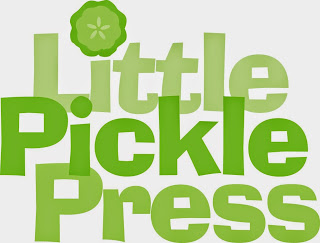
If you’re going to aim high, you need the right launch pad. Does your goal involve writing the next great children’s book or YA novel? Little Pickle Press wants to know about it, and we’re working with Submittable to make it even easier to share your best ideas with us.
Step 1: Write!
We can’t read your mind, so get those fabulous ideas written down. Bear in mind that while there are scores of topics to choose from, the mission statement of Little Pickle Press is your best guide to the sort of manuscripts that we’re seeking. These include (in no particular order and not exclusively):

- Altruism (and other anti-narcissism, anti-entitlement themes)
- Dare To Be Different
- Tolerance/Acceptance
- Non-traditional family structures
- Choices: It’s Not All Black And White; Most of Life is Gray
- Anti-Princess Themes
- Strong, female protagonists
- Creativity—the importance of it, fostering it, etc.
- Divergent (vs. Convergent) Thinking
- Systems Thinking
- Self-Sufficiency/Taking Care of Yourself and Your Community/Planting the Seeds of Being a Locavore
- Water as a precious, global resource
- Creativity: the importance of it, fostering it, etc.
- Forgiveness
- Gratitude
- What is a conscience? How do we foster it? Use it?
- Leadership and/or Entrepreneurship
We’re growing with our readers, so don’t think you have to create a picture book if you have a novel rattling around in your brain. We’re seeking picture books for 5 to 8 year olds, chapter books for 9 to 12 year olds, and middle grade novels for 10 to 14 year olds. In addition, we’re now accepting manuscripts in the young adult novel category for readers ages 15 and up. We are open to the literary vehicle employed to convey the story—fiction, historical fiction, fantasy, science fiction, creative nonfiction, etc.
Step 2: Get it ready!
Okay, so you’ve written your book. You’ve shared it with friends, family, and that neighbor down the street who’s known for disliking pretty much everything. They all agree that your book is the best thing since sliced bread. Now what?
Now you or your agent can send it to us! We’ve got a few uniformity guidelines to keep all submissions easy to read, and here they are:
- As an MS Word document
- Double-spaced
- With Times New Roman font 12-pt
- With your suggested title and name at the top as well as a word count
- With pages numbered
- Without illustrations
Relatively painless, wouldn’t you say? That’s because we’ve been saving the hard part for last. Everybody has a creative spark, and following instructions is a snap. Now for the really tough step.

Step 3: Send it in!
Sending your carefully-wrought manuscript off to a real, live publishing company is one of the most exciting and stressful things that you can do. But don’t worry. We don’t bite. Follow the submissions link, take a deep breath, and click!
Step 4: Sit back, but don’t relax just yet.
We have lots of manuscripts to consider, so it will take up to 8 weeks before we get back to you. While you’re waiting, why not see what other great story ideas you’ve got? Children need and deserve books. Whether it’s an imaginative tale that encourages creativity, or an engaging story that fosters responsibility and social awareness, Little Pickle Press seeks to offer the very best in children’s literature. Will you help us?
Hope this information helps push you closer to finding a home for your book.
Talk tomorrow,
Kathy
Filed under:
Middle Grade Novels,
opportunity,
picture books,
Places to Submit,
publishers,
Young Adult Novel Tagged:
Emma D Dryden,
Little Pickle Press,
Rana DiOrio,
submission guidelines 

By:
Gi Hallmark,
on 9/28/2014
Blog:
The Children's Book Review
(
Login to Add to MyJacketFlap)
JacketFlap tags:
HarperCollins,
Ages 4-8,
Ages 9-12,
Picture Books,
Book Lists,
Scholastic,
Bedtime Stories,
Zen,
Bedtime Books,
Mindfulness,
Animal Books,
Aliki,
Mediation,
Thich Nhat Hanh,
Rana DiOrio,
Jon J Muth,
Leo Tolstoy,
Little Pickle Press,
Eliza Wheeler,
Cultural Wisdom,
Social Graces,
Paul Showers,
Being Present,
Dharmachari Nagaraja,
Jessica McClure,
Parallax Press,
Short Fables,
Watkins Publishing,
Add a tag
Kids books are a fantastic mechanism to start the discussion with young readers on what is mindfulness and ways to incorporate it into lives.

By: Kathy Temean,
on 12/2/2011
Blog:
Writing and Illustrating
(
Login to Add to MyJacketFlap)
JacketFlap tags:
Little Pickle Press,
Eliza Wheeler,
SCBWI 2011 Los Angeles International Conference Portfolio Grand Prize,
awards,
picture books,
inspiration,
Process,
authors and illustrators,
Picture book Illustrator,
Illustrator's Saturday,
Add a tag
 I noticed Eliza’s portfolio when I was out in LA at the SCBWI Summer Conference this year. The Art Exhibit was teaming with talent, but Eliza took the Grand Prize with her portfolio. I know you will enjoy your visit with her.
I noticed Eliza’s portfolio when I was out in LA at the SCBWI Summer Conference this year. The Art Exhibit was teaming with talent, but Eliza took the Grand Prize with her portfolio. I know you will enjoy your visit with her.
I grew up in Northern Wisconsin in a family of teachers, musicians, and artists. Drawing was my favorite form of play as a child, my emotional outlet as a teen, and is my escape as an adult. Some of the strongest influences on my creativity have been the wild Wisconsin seasons, canoeing the Brule River, picking blueberries with my Grandmother, and digging through the snow with my brothers.
I got a degree in art and design at the University of Wisconsin-Stout in 2006, moved to Los Angeles and searched for my place as an artist in the “real world”. In 2009 I attended my first national conference for the Society of Children’s Book Writer’s and Illustrators (SCBWI) and felt immediately at home. Children’s literature allows me to experience my own childhood again; to reconnect with and express the imagination as vividly as the time I was building forts in the woods and playing with dolls. Little has changed; only now the worlds I imagine I have the ability to share.
In spring 2010 I illustrated the book What Does It Mean To Be Present? written by Rana DiOrio of Little Pickle Press. In July of that same year I received the SCBWI LA conference mentorship program award, the catalyst for my 2011 win of the portfolio showcase grand prize award! Currently I’m in the process of developing several of my own stories, including a picture book to be published with Nancy Paulsen/Penguin Books for Young Readers.
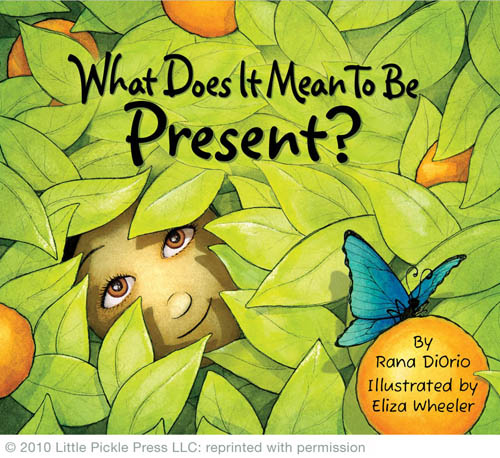
Above is the cover of the first picture book that she has illustrated. Now let’s take a look at her process. Here’s Eliza:
I start with a small thumbnail sketch, about 1 by 2 inches. This usually happens in my sketchbook where I do most of my thinking. The kernel of the idea is a few basic shapes, and then I do a slightly more detailed thumbnail of the scene.
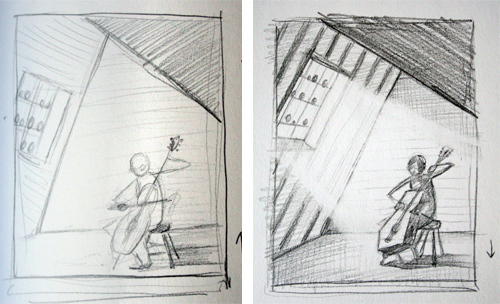
At this point I usually hit up Google Images, collecting reference imagery that relates to my idea – scenery, characters, objects, lighting, etc. I’ll usually do some sketches of those objects and settings.
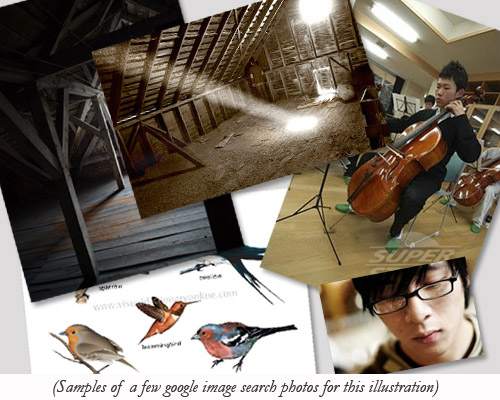
Sometimes I’ll build a crude model to help aid with perspective or to get a feel for the lighting. I’ll use whatever materials are on hand, in the case of this drawing; a pizza box for the walls and modeling clay for the figure.
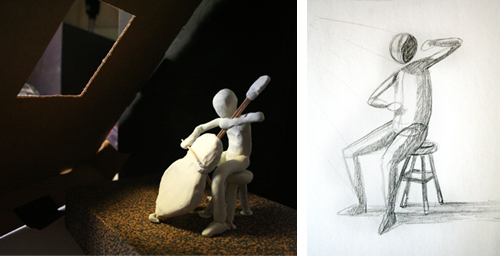
A part of my process not shown here is to enlarge my thumbnail, do a rough sketch on a cheap tracing paper on top of that, enlarge that sketch to 100% and do my final pencil drawing on nice tracing paper (Graphics 360 Marker Paper). I scan that drawing in and print it out with my Epson Stylus 2880 on the final water

By: Kathy Temean,
on 12/2/2011
Blog:
Writing and Illustrating
(
Login to Add to MyJacketFlap)
JacketFlap tags:
awards,
picture books,
inspiration,
Process,
authors and illustrators,
Picture book Illustrator,
Illustrator's Saturday,
Little Pickle Press,
Eliza Wheeler,
SCBWI 2011 Los Angeles International Conference Portfolio Grand Prize,
Add a tag
 I noticed Eliza’s portfolio when I was out in LA at the SCBWI Summer Conference this year. The Art Exhibit was teaming with talent, but Eliza took the Grand Prize with her portfolio. I know you will enjoy your visit with her.
I noticed Eliza’s portfolio when I was out in LA at the SCBWI Summer Conference this year. The Art Exhibit was teaming with talent, but Eliza took the Grand Prize with her portfolio. I know you will enjoy your visit with her.
I grew up in Northern Wisconsin in a family of teachers, musicians, and artists. Drawing was my favorite form of play as a child, my emotional outlet as a teen, and is my escape as an adult. Some of the strongest influences on my creativity have been the wild Wisconsin seasons, canoeing the Brule River, picking blueberries with my Grandmother, and digging through the snow with my brothers.
I got a degree in art and design at the University of Wisconsin-Stout in 2006, moved to Los Angeles and searched for my place as an artist in the “real world”. In 2009 I attended my first national conference for the Society of Children’s Book Writer’s and Illustrators (SCBWI) and felt immediately at home. Children’s literature allows me to experience my own childhood again; to reconnect with and express the imagination as vividly as the time I was building forts in the woods and playing with dolls. Little has changed; only now the worlds I imagine I have the ability to share.
In spring 2010 I illustrated the book What Does It Mean To Be Present? written by Rana DiOrio of Little Pickle Press. In July of that same year I received the SCBWI LA conference mentorship program award, the catalyst for my 2011 win of the portfolio showcase grand prize award! Currently I’m in the process of developing several of my own stories, including a picture book to be published with Nancy Paulsen/Penguin Books for Young Readers.

Above is the cover of the first picture book that she has illustrated. Now let’s take a look at her process. Here’s Eliza:
I start with a small thumbnail sketch, about 1 by 2 inches. This usually happens in my sketchbook where I do most of my thinking. The kernel of the idea is a few basic shapes, and then I do a slightly more detailed thumbnail of the scene.

At this point I usually hit up Google Images, collecting reference imagery that relates to my idea – scenery, characters, objects, lighting, etc. I’ll usually do some sketches of those objects and settings.

Sometimes I’ll build a crude model to help aid with perspective or to get a feel for the lighting. I’ll use whatever materials are on hand, in the case of this drawing; a pizza box for the walls and modeling clay for the figure.

A part of my process not shown here is to enlarge my thumbnail, do a rough sketch on a cheap tracing paper on top of that, enlarge that sketch to 100% and do my final pencil drawing on nice tracing paper (Graphics 360 Marker Paper). I scan that drawing in and print it out with my Epson Stylus 2880 on the final water



 Lee Wind is the Vice President of Digital, Communications and Community Engagement at Little Pickle Press.
Lee Wind is the Vice President of Digital, Communications and Community Engagement at Little Pickle Press.













 I noticed Eliza’s portfolio when I was out in LA at the SCBWI Summer Conference this year. The Art Exhibit was teaming with talent, but Eliza took the Grand Prize with her portfolio. I know you will enjoy your visit with her.
I noticed Eliza’s portfolio when I was out in LA at the SCBWI Summer Conference this year. The Art Exhibit was teaming with talent, but Eliza took the Grand Prize with her portfolio. I know you will enjoy your visit with her.



Thank you Kathy for this opportunity you reported on but I have one question. On the submission page, under the “Cover Letter” box it has another empty box stating, “text box label”. What is that?
Sally,
I’m sorry, but I can’t find the page that you are on. I don’t see anything that says, “Cover Letter.” Perhaps you could provide the link and tell me where it is on the page.
Kathy
Thanks– hadn’t heard of LITTLE PICKLE before. They look really interesting!
Thanks for your quick response. Here is the address to the page (and hopefully the box) in question:
https://littlepicklepress.submittable.com/submit/26773#_=_
I totally support the rave reviews! our agency has worked with those at Little Pickle and enjoyed the relationship VERY much. Thank you for bringing them into view!
we highly enjoyed working with Little Pickle Press! glad to see this….
Great info. I will look into it!